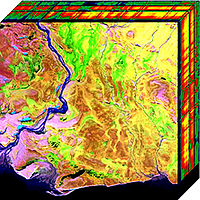
Photo from wikipedia
Infrared ion spectroscopy (IRIS) continues to see increasing use as an analytical tool for small-molecule identification in conjunction with mass spectrometry (MS). The IR spectrum of an m/z selected population… Click to show full abstract
Infrared ion spectroscopy (IRIS) continues to see increasing use as an analytical tool for small-molecule identification in conjunction with mass spectrometry (MS). The IR spectrum of an m/z selected population of ions constitutes a unique fingerprint that is specific to the molecular structure. However, direct translation of an IR spectrum to a molecular structure remains challenging, as reference libraries of IR spectra of molecular ions largely do not exist. Quantum-chemically computed spectra can reliably be used as reference, but the challenge of selecting the candidate structures remains. Here, we introduce an in silico library of vibrational spectra of common MS adducts of over 4500 compounds found in the human metabolome database. In total, the library currently contains more than 75,000 spectra computed at the DFT level that can be queried with an experimental IR spectrum. Moreover, we introduce a database of 189 experimental IRIS spectra, which is employed to validate the automated spectral matching routines. This demonstrates that 75% of the metabolites in the experimental data set are correctly identified, based solely on their exact m/z and IRIS spectrum. Additionally, we demonstrate an approach for specifically identifying substructures by performing a search without m/z constraints to find structural analogues. Such an unsupervised search paves the way toward the de novo identification of unknowns that are absent in spectral libraries. We apply the in silico spectral library to identify an unknown in a plasma sample as 3-hydroxyhexanoic acid, highlighting the potential of the method.
Journal Title: Analytical chemistry
Year Published: 2023
Link to full text (if available)
Share on Social Media: Sign Up to like & get
recommendations!